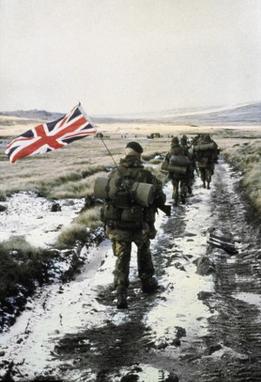Yomp facts for kids

Yomp is a special word used by the Royal Marines. It means to go on a very long march while carrying all your heavy gear. This word became well-known in 1982 because of news reports during the Falklands War. No one is quite sure where the word "yomp" came from. Some people have made up ideas for what it might stand for, like "young officers marching pace." But there's no real proof for these ideas.
Contents
What is a Yomp?
A yomp is a tough, long walk that soldiers do. They carry all their heavy equipment, like their backpacks, weapons, and supplies. This kind of march helps soldiers get ready for difficult missions. It also helps them build strength and teamwork.
Why is it called a "Yomp"?
The exact start of the word "yomp" is a bit of a mystery. It's a unique term mostly used by the Royal Marines. Some people think it might be linked to the word "yump," which is used in car rallying. That word means to leave the ground when going over a hill very fast. It sounds a bit like "jump."
The Falklands War Yomp
The word "yomp" became famous in the United Kingdom during the Falklands War in 1982. This war happened far away in the South Atlantic.
Why did soldiers yomp in the Falklands?
On May 21, 1982, Royal Marines and soldiers from the Parachute Regiment landed on East Falkland island. They were supposed to be flown by helicopters across the island. However, a ship called the SS Atlantic Conveyor was hit by missiles on May 25. This ship was carrying many of their helicopters. Because the helicopters were lost, the soldiers had to march instead.
The long march across the island
These brave soldiers yomped (or "tabbed," as some call it) across the islands. They walked about 56 miles (90 kilometers) in just three days. Each soldier carried a very heavy load, weighing around 80 pounds (36 kilograms). This incredible march showed their strength and determination.
The Famous "Yomper" Photograph
One of the most famous pictures from the Falklands War is known as "the Yomper." It shows a Royal Marine named Corporal Peter Robinson.
Who took the picture?
The photo was taken by Petty Officer Peter Holdgate. He was a photographer for the Commando Forces News Team. He landed with the soldiers and took many pictures as they marched. He followed the Royal Marines on their way to Stanley.
The story behind the flag
When the news came that the Argentine forces had surrendered, a Marine named Willy Evans found a small Union Jack flag. He had gotten it from a ship called the SS Canberra. Marine Evans first tied the flag to Corporal Robinson's radio antenna. Corporal Robinson was the last person in their group. The flag blew off, so they taped it back on. The photograph was taken at that exact moment. It was not planned or set up. The original flag has since been lost.
A memorial to the "Yomper"
The famous photograph inspired a statue. This statue shows a Royal Marine Commando. It was officially shown to the public by Margaret Thatcher on July 8, 1992. This happened at the Royal Marines Museum in Portsmouth, UK. The statue was created to remember the 10th anniversary of the Falklands War.
Other Words for Long Marches
Different armies have their own words for a long, heavy march.
- The British Army calls a similar march a "tab." Some people think "tab" might stand for "Tactical Advance to Battle."
- The U.S. Military uses words like "ruck" or "hump." "Ruck" comes from "rucksack," which is a type of backpack. "Hump" comes from the phrase "humping a pack."
See also
- Dartmoor Yomp
- Loaded march

